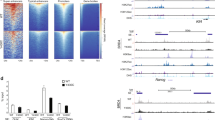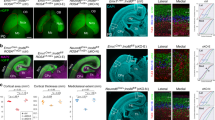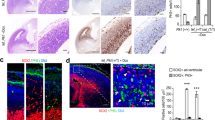Abstract
Microcephalin (MCPH1/BRIT1) forms ionizing radiation-induced nuclear foci (IRIF) and is required for DNA damage-responsive S and G2-M-phase checkpoints. MCPH1 contains three BRCT domains. Here we report the cloning of chicken Mcph1 (cMcph1) and functional analysis of its individual BRCT domains. Full-length cMcph1 localized to centrosomes throughout the cell cycle and formed IRIF that colocalized with γ-H2AX. The tandem C-terminal BRCT2 and BRCT3 domains of cMcph1 were necessary for IRIF formation, while the N-terminal BRCT1 was required for centrosomal localization in irradiated cells. Centrosomal targeting of cMcph1 was independent of ATM, Brca1 or Chk1. cMcph1 formed IRIF in ATM- and Brca1-deficient cells, but not in H2AX-deficient cells. Inability to form cMcph1 IRIF impaired the cellular response to DNA damage. These results suggest that the role of microcephalin in the vertebrate DNA damage response is controlled by interaction of the C-terminal BRCT domains with γ-H2AX.
This is a preview of subscription content, access via your institution
Access options
Subscribe to this journal
Receive 50 print issues and online access
$259.00 per year
only $5.18 per issue
Buy this article
- Purchase on Springer Link
- Instant access to full article PDF
Prices may be subject to local taxes which are calculated during checkout




Similar content being viewed by others
Accession codes
References
Alderton GK, Galbiati L, Griffith E, Surinya KH, Neitzel H, Jackson AP et al. (2006). Regulation of mitotic entry by microcephalin and its overlap with ATR signalling. Nat Cell Biol 8: 725–733.
Au WW, Henderson BR . (2005). The BRCA1 RING and BRCT domains cooperate in targeting BRCA1 to ionizing radiation-induced nuclear foci. J Biol Chem 280: 6993–7001.
Bartek J, Lukas J . (2003). Chk1 and Chk2 kinases in checkpoint control and cancer. Cancer Cell 3: 421–429.
Bond J, Roberts E, Springell K, Lizarraga SB, Scott S, Higgins J et al. (2005). A centrosomal mechanism involving CDK5RAP2 and CENPJ controls brain size. Nat Genet 37: 353–355.
Celeste A, Fernandez-Capetillo O, Kruhlak MJ, Pilch DR, Staudt DW, Lee A et al. (2003). Histone H2AX phosphorylation is dispensable for the initial recognition of DNA breaks. Nat Cell Biol 5: 675–679.
Celeste A, Petersen S, Romanienko PJ, Fernandez-Capetillo O, Chen HT, Sedelnikova OA et al. (2002). Genomic instability in mice lacking histone H2AX. Science 296: 922–927.
Dodson H, Bourke E, Jeffers LJ, Vagnarelli P, Sonoda E, Takeda S et al. (2004). Centrosome amplification induced by DNA damage occurs during a prolonged G2 phase and involves ATM. EMBO J 23: 3864–3873.
Glover JN, Williams RS, Lee MS . (2004). Interactions between BRCT repeats and phosphoproteins: tangled up in two. Trends Biochem Sci 29: 579–585.
Haren L, Remy MH, Bazin I, Callebaut I, Wright M, Merdes A . (2006). NEDD1-dependent recruitment of the gamma-tubulin ring complex to the centrosome is necessary for centriole duplication and spindle assembly. J Cell Biol 172: 505–515.
Jackson AP, Eastwood H, Bell SM, Adu J, Toomes C, Carr IM et al. (2002). Identification of microcephalin, a protein implicated in determining the size of the human brain. Am J Hum Genet 71: 136–142.
Lin SY, Elledge SJ . (2003). Multiple tumor suppressor pathways negatively regulate telomerase. Cell 113: 881–889.
Lin SY, Rai R, Li K, Xu ZX, Elledge SJ . (2005). BRIT1/MCPH1 is a DNA damage responsive protein that regulates the Brca1-Chk1 pathway, implicating checkpoint dysfunction in microcephaly. Proc Natl Acad Sci USA 102: 15105–15109.
Manke IA, Lowery DM, Nguyen A, Yaffe MB . (2003). BRCT repeats as phosphopeptide-binding modules involved in protein targeting. Science 302: 636–639.
Neitzel H, Neumann LM, Schindler D, Wirges A, Tonnies H, Trimborn M et al. (2002). Premature chromosome condensation in humans associated with microcephaly and mental retardation: a novel autosomal recessive condition. Am J Hum Genet 70: 1015–1022.
Paull TT, Rogakou EP, Yamazaki V, Kirchgessner CU, Gellert M, Bonner WM . (2000). A critical role for histone H2AX in recruitment of repair factors to nuclear foci after DNA damage. Curr Biol 10: 886–895.
Rai R, Dai H, Multani AS, Li K, Chin K, Gray J et al. (2006). BRIT1 regulates early DNA damage response, chromosomal integrity, and cancer. Cancer Cell 10: 1–13.
Rogakou EP, Boon C, Redon C, Bonner WM . (1999). Megabase chromatin domains involved in DNA double-strand breaks in vivo. J Cell Biol 146: 905–916.
Shiloh Y . (2003). ATM and related protein kinases: safeguarding genome integrity. Nat Rev Cancer 3: 155–168.
Sonoda E, Zhao GY, Kohzaki M, Dhar PK, Kikuchi K, Redon C et al. (2007). Collaborative roles of gammaH2AX and the Rad51 paralog Xrcc3 in homologous recombinational repair. DNA Repair (Amst) 6: 280–292.
Starita LM, Parvin JD . (2003). The multiple nuclear functions of BRCA1: transcription, ubiquitination and DNA repair. Curr Opin Cell Biol 15: 345–350.
Stucki M, Clapperton JA, Mohammad D, Yaffe MB, Smerdon SJ, Jackson SP . (2005). MDC1 directly binds phosphorylated histone H2AX to regulate cellular responses to DNA double-strand breaks. Cell 123: 1213–1226.
Trimborn M, Bell SM, Felix C, Rashid Y, Jafri H, Griffiths PD et al. (2004). Mutations in microcephalin cause aberrant regulation of chromosome condensation. Am J Hum Genet 75: 261–266.
Vandenberg CJ, Gergely F, Ong CY, Pace P, Mallery DL, Hiom K et al. (2003). BRCA1-independent ubiquitination of FANCD2. Mol Cell 12: 247–254.
Xu X, Lee J, Stern DF . (2004). Microcephalin is a DNA damage response protein involved in regulation of CHK1 and BRCA1. J Biol Chem 279: 34091–34094.
Yu X, Chini CC, He M, Mer G, Chen J . (2003). The BRCT domain is a phospho-protein binding domain. Science 302: 639–642.
Zachos G, Rainey MD, Gillespie DA . (2003). Chk1-deficient tumour cells are viable but exhibit multiple checkpoint and survival defects. EMBO J 22: 713–723.
Acknowledgements
We thank Kevin Hiom, David Gillespie and Shunichi Takeda for cell lines, Andreas Merdes and Shiaw-Yih Lin for antisera and Noel Lowndes for discussion. BJC is supported by Project Grant RP/2005/7 from the Health Research Board. The work in CGM's laboratory is funded by a Science Foundation Ireland Investigator award.
Author information
Authors and Affiliations
Corresponding author
Additional information
Supplementary Information accompanies the paper on the Oncogene website (http://www.nature.com/onc).
Supplementary information
Rights and permissions
About this article
Cite this article
Jeffers, L., Coull, B., Stack, S. et al. Distinct BRCT domains in Mcph1/Brit1 mediate ionizing radiation-induced focus formation and centrosomal localization. Oncogene 27, 139–144 (2008). https://doi.org/10.1038/sj.onc.1210595
Received:
Revised:
Accepted:
Published:
Issue Date:
DOI: https://doi.org/10.1038/sj.onc.1210595
Keywords
This article is cited by
-
Aging-induced MCPH1 translocation activates necroptosis and impairs hematopoietic stem cell function
Nature Aging (2024)
-
The N-terminal BRCT domain determines MCPH1 function in brain development and fertility
Cell Death & Disease (2021)
-
Analysis of the “centrosome-ome” identifies MCPH1 deletion as a cause of centrosome amplification in human cancer
Scientific Reports (2020)
-
Primary microcephaly with an unstable genome
Genome Instability & Disease (2020)
-
Centrosomes in the DNA damage response—the hub outside the centre
Chromosome Research (2016)



